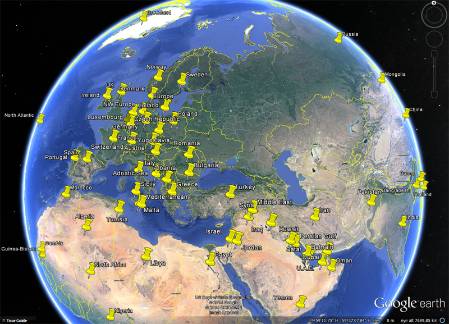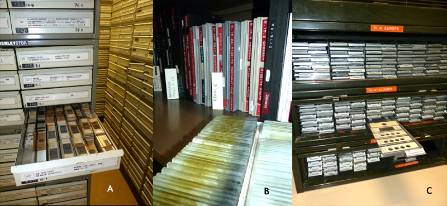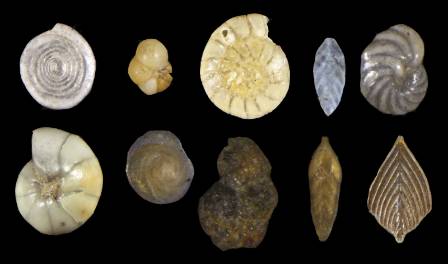I was feeling very nostalgic this week as I helped to process a loan of 450 slides from a collection I curated back in 1994. The Former British Petroleum Microfossil Collection was donated to us in 1991 when BP closed their micropalaeontology operations at Sunbury.
Part of the Google Earth Map compiled by Steve Stukins to show the global distribution of well material in the collection.
A major new project funded by BP is re-visiting this collection, imaging and re-identifying the material and looking at associated documentation to deliver data in new and innovative ways.
The Former BP Microfossil Collection
The collection consists of over 300,000 items of slides and microfossil residues collected from over 4,000 wells worldwide that were drilled by BP from the late 1960s until the early 1990s. Microfossils represented are mainly foraminifera and palynomorphs but there are also smaller numbers of nannofossil preparations and ostracods.
Examples of slides in the Former BP Microfossil Collection from the (A) Well-run, (B) Palynology and (C) NW European Foraminiferal Reference collections.
The collection is split into three parts:
- The Reference Collection - BP's "type" collection of slides of individual identified foraminiferal and ostracod specimens.
- The Well-run Collection - slides of picked microfossil assemblages and residues generated from mainly well cuttings.
- The Palynology and Nannofossil Collection - microscopic organic and calcareous remains on glass slides.
Current collection usage
The main users of the collection are currently MSc students supervised by my colleague Steve Stukins doing projects as part of the University of Birmingham course on Applied and Petroleum Micropalaeontology . Funds from the project allow students to travel to London to view the collection and for us to process loans of the material so they can study it in Birmingham for their final projects.
Documentation issues
Much of the collection has BP-coded identifications (e.g. Species number 12 Subspecies 1) that are referred to in reports currently held by BP. As a result it is difficult to answer very specific enquiries about the collection and a visit to re-examine the material is sometimes the only way to make up-to-date interpretations.
Images of foraminifera from the North West European Reference collection taken by Kelly Smith.
As part of the project we have been able to bring in foraminiferal expert Haydon Bailey of Network Stratigraphic Consulting Ltd, a company that mainly specialises in providing micropalaeontological support to the oil industry. He has been providing up-to-date identifications of the material in the collection. Later in the project we will be able to employ a post doctoral worker to synthesise this information with data from well reports.
New images
We have been able to purchase a new imaging microscope as part of the project. This takes a series of closely focussed images through the depth of each specimen and, using software, combines these slices into a single focussed image. Each of the slides in the North West European part of the Foraminiferal Reference Collection is being imaged and this will be delivered via the Museum's data portal.
Delivering data in a new way
The data is also being combined into a Geographic Information System (GIS) called PalaeoGIS that tracks the positions of the continents, oceans and seas through time. The interpreted age and palaeoenvironmental data from each well in the collection will be used to identify the relevant GIS time slices on which to plot environments and show images of specimens.
Uses of the data and collection
Tom Hill, project leaders says:
"This data has remained confidential for some time, but there is a vast archive of scientific data from as far back as the 1950s that could be re-evaluated using the latest computer modelling technology and the most recent micropalaeontology literature. The development of a global GIS model of tectonics, stratigraphy and palaeoenvironments could also be developed into a valuable resource enabling the public to learn about Earth history."
As a curator I hate to think that I have spent a lot of time curating a collection only for it to lie dormant. The six years at the start of my career here at the Museum were spent ordering and documenting this collection so I am really pleased that the research value of the collection is finally being realised by this focussed and innovative project.
The BP Project team Robin Whittaker, Giles Miller, Steve Stukins, Tom Hill and Kelly Smith in front of the Nikon SMZ25 microscope.
There are literally thousands of potential industrial and academic projects available and this North West European pilot project is a major step towards mobilising the data from this collection. Details of the Former British Petroleum Microfossil Collection can be found online and the collection is available for study by academics, industrial micropalaeontologists or anyone with an interest on request.






